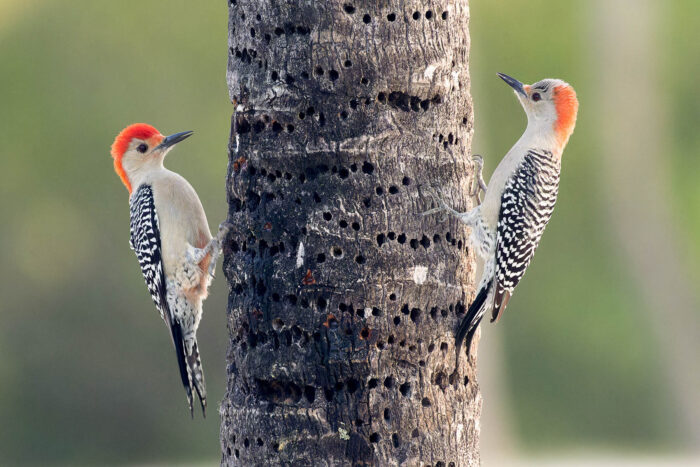Red-Bellied Woodpecker
Melanerpes carolinus
The red-bellied woodpecker is a medium-sized bird that drills into trees looking for food to eat.
This section shows one large critter image at a time. Use the thumbnails that follow to select a specific image to display here.

This gallery contains a grid of small thumbnails. Selecting a thumbnail will change the main image in the preceding section.
Appearance
The red-bellied woodpecker is a medium-sized bird with pale coloring on its underside, a black and white patterned back and red flashes on its head and neck. The species has a sharply pointed black beak.
Feeding
The red-bellied woodpecker forages by searching for insects on tree trunks and limbs. They also climb among branches to find berries, nuts and seeds. They often store nuts and seeds in the crevices of tree bark to be eaten during the winter. The diet of the red-bellied woodpecker sometimes includes tree frogs, eggs of small birds and small fish.
Predators
Known predators of the red-bellied woodpecker include hawks and other birds of prey, snakes and house cats.
Voice
The red-bellied woodpecker sings a repeated chuck-chuck-chuck, descending in pitch. They also have a loud, high-pitched, often repeated churrr call.
Reproduction and life cycle
Male red-bellied woodpeckers dig several holes in dead trees to serve as potential nesting sites. Females pick which nesting site will be used. Red-bellied woodpeckers in the Chesapeake region typically have one brood per year, while further south, they have up to three. Clutches typically consist of three to eight eggs that are incubated by both parents for 12 to 14 days. After hatching, young are fed by both parents until they are ready to leave the nest at about 22 to 27 days old.
Did you know?
- Despite their name, the belly of this species is typically pale white in color. If there are any red flashes, they are typically difficult to see.
- When approached by a predator, the red-bellied woodpecker often hides or harasses it with alarm calls, sometimes even attacking a predator that approaches their nest or young.
- Red-bellied woodpeckers will “play” with each other by flying and dodging among trees as if attempting to escape predators.
Sources and additional information
- Red-bellied woodpecker - National Audubon Society
- Red-bellied woodpecker (melanerpes carolinus) - University of Michigan Critter Catalogue
- Red-bellied Woodpecker - Cornell Lab All About Birds
- Red-bellied Woodpecker - National Wildlife Federation
